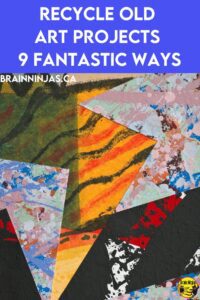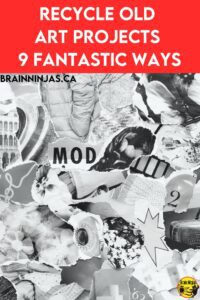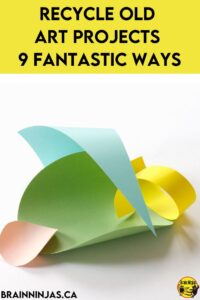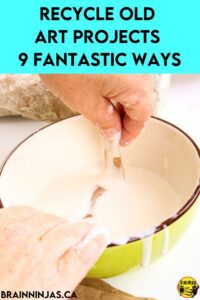
If you have a bunch of completed art projects or partially completed ones, we came up with a whole bunch of ways to recycle them into new things. Recycling art projects not only helps reduce waste but also encourages creativity and resourcefulness.
Before we recycle any piece of art, we encourage students to take a picture so it can be remembered but won’t take up space. This is so that students can see how they grow and change as artists as opposed to keeping it as a memory.
We hate wasting materials, so whenever possible, we recycle pieces of art projects and craft materials so they can be used again in the future. The last thing we want is for art projects to be thrown into the landfill. Sometimes we do art projects that are not meant for display because we are practicing skills. These are the ones we recycle first.
Create a Collage from Recycled Items

Cut up old paintings or drawings into different shapes and sizes and use them to create a new collage. You can add other materials like magazine clippings, fabric, or buttons to make it even more interesting.
Decoupage pieces of art projects onto bottles or jars to make new items. Choose things with different textures to add interest. Use a bit of ModPodge or white glue to seal up all the edges.
We created these kindness art projects a few years ago, and you could use old paintings to make all the strips. Read more about this project in this post, How to Weave Kindness into the Classroom Every Day.
Mixed Media Art
Incorporate your old art into a new mixed media piece by adding other materials like paint, pastels, or charcoal. You can also add elements like found objects, fabric, or thread to create texture and dimension. Mounting the project on cardboard will help keep it from falling apart.
We created this project using old books, but you could easily put this artwork onto any piece of art you have lying around. Get the Upcycled Art Project in our Resource Library, which is available to anyone already on our email list. If you’re not on the list, we can send it directly to your inbox when you sign up.
Recycle Paper into a Sculpture

Use your old artwork as the base for a new sculpture. You can use it as a starting point for a new piece or add to it with materials like wire, clay, or paper mache.
You can also turn paper into a mixture that can be used like clay. Tear it up into small pieces. Place it in a blender with a sprinkle of flour and water. Blend the mixture, but keep adding water until you get it mixed really well. Chances are your mixture will turn out brown if you’ve used paper that had paint on it. Remove the mixture from the blender and work it with your hands. You should be able to form it. If it doesn’t stay together, add more flour and water and blend it more.
Use the mixture to create a sculpture. Leave the sculpture to dry over several days. It may leach out dirty water (from any paint), so make sure you place it on something that can be easily cleaned.
Once your sculptures are completely dry, they can be painted. No one will ever know you shredded old art projects to make them.
Art Trading Cards
Cut up your old artwork into small, trading card-sized pieces and use them as the base for a new set of art trading cards. Add in other materials like paint, markers, or stamps to create a new set of unique cards. Our students made a deck of cards. You could also make a set of cards that feature different artists on one side or certain works of art on the other.
One student turned their art projects into a set of math flashcards, and another drew characters from a favourite video game.

If all your students create a set of cards, they could trade them.
Paint Over It
If you don’t want to keep your old artwork, you can always paint over it with a new design. Use paint that will cover up the old artwork completely, then create a new painting on top of it. We use liquid Tempera paint for a lot of our artwork. You don’t have to use white to paint over the old painting. In fact, you’ll get a really interesting canvas if you use a different colour.
Once your canvas is ready, you can paint a new work of art.
Generally, we follow the rule to cover the paint with the same type of paint. For watercolour, we use water to water down the paper, which will wash off most of the paint. This only works for high-quality watercolour paper. If the painting is not on thick paper, it might be best to recycle the project a different way.
Make Greeting Cards or Gift Tags
Turn old paintings or drawings into gift tags, greeting cards, or postcards. We had students get measurements of cards, tags, and postcards and then used a paper cutter to cut our projects into pieces.
We used a hole punch to make a hole for the gift tags and added a string so it could be tied onto the gifts. Some students wrote To/From on them as well.
Artwork also looks great on the front of a greeting card. Students can gift the cards to people throughout the school year.
We reused our art projects to make Mother’s Day and Father’s cards (and other cards for our friends and family throughout the school year. If you need more gift ideas, check out our post, Inexpensive and Easy to Make Mother’s Day Ideas. Don’t worry; the gift ideas can work for anyone at any time of year.
Create Gift Wrap or Gift Bags
Use old art projects to make wrapping paper or gift bags. Large pieces can be easily used as wrapping paper for small gifts. Small pieces of artwork are better as gift tags.
We created beautiful Christmas Tree art projects using some of our practice projects and wrapping paper. You can find the project in our post 12 Simple Christmas Tree Projects We Love.
Make a Book Cover, Notebook or Journal
Use old artwork to create a personalized notebook or journal cover. Use your old artwork as a starting point for a new art journal. Cut it up and use it as a background, then add in other elements like paint, markers, or stamps to create a new page. Students can use paper that is good on one side of the page of the notebook.
Create a Piece of Jewelry
Turn old art projects into unique pieces of jewelry by using them as pendants, charms, or earrings. Students may need some additional materials to do these projects, but they will have a memorable piece when they are all done.
Looking for other inspiring art projects?

We have written several different art lessons. Each lesson comes with step-by-step instructions, photos of the steps and completed projects, and ideas for how to assess the work. Student reflection pages in English and French are also included.
Artists of Canada – Find it on TpT ($USD) and our BN Shop ($CAN).
Geography and Landscape Art Projects – Find it on TpT ($USD) and our BN Shop ($CAN).
Halloween Art Lessons – Find it on TpT ($USD) and our BN Shop ($CAN).
Indigenous Artists in Canada – Find it on TpT ($USD) and our BN Shop ($CAN).
Upcycled Art (Waste in Our World) – Find it on TpT ($USD) and our BN Shop ($CAN).
Winter Art Projects – Find it on TpT ($USD) and our BN Shop ($CAN).
Christmas Art Lessons – Find it on TpT ($USD) and our BN Shop ($CAN).
Light and Shadow Art Projects – Find it on TpT ($USD) and our BN Shop ($CAN).
Plants Art Lessons – Find it on TpT ($USD) and our BN Shop ($CAN).
All of the sets listed above are included in our Art Lesson Bundle (so you get them at a discount). Find it on TpT ($USD) and our BN Shop ($CAN).
Have you ever recycled a piece of art into something new? We’d love to hear about it. Share a comment with us below.







